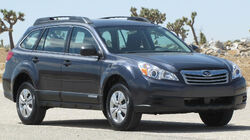 | |
| Manufacturer | Subaru |
|---|---|
| Parent company | Fuji Heavy Industries |
| Production | 1995–present |
| Assembly |
Ōta, Gunma, Japan Lafayette, Indiana, USA |
| Class |
Mid-size station wagon / crossover SUV Mid-size car (sedan) |
| Layout | F4 layout |
The Subaru Outback is a crossover automobile manufactured by Subaru since 1995. Its original concept originated with Subaru of America, which was suffering from slumping sales in the mid-1990s partly due to a lack of an entry in the then-burgeoning sport utility vehicle market. Lacking the finances to design an all-new sport utility vehicle, Subaru decided to add body cladding and a suspension lift to their Legacy wagon. Christened the Legacy Outback, after the rugged areas of Australia, Australian actor Paul Hogan was the spokesman in the North American market, playing off the Australian name of the vehicle and portraying the vehicle as a capable and more efficient alternative to larger, truck-based SUVs.
All Outbacks sold worldwide are equipped with all wheel drive as standard equipment, the only drivetrain setup available.
Sales exceeded expectations, with Tim Mahoney, Senior Vice President of Subaru of America stating "[the Outback] saved our company."[1]
Subaru introduced the Outback to Japan as the Legacy Grand Wagon–then renamed Legacy Lancaster in model year 1997. In 2004, the Outback name was adopted worldwide and moved to its own model line (except in Japan). All vehicles in the Outback line are derived from Subaru's Legacy, except the Outback Sport (aka Impreza Outback), which is derived from the Impreza hatchback.
Some[1] credit Subaru for inventing the crossover genre with the Outback, while others point to it as the first in a resurgence of a class of vehicles that started with American Motors' Eagle wagon, launched in 1979.
First generation (1995–1999)[]
 | |
| Also called |
Subaru Legacy Grand Wagon (MY99) Subaru Legacy Lancaster |
|---|---|
| Production | 1995–1999 |
| Body style(s) |
5-door station wagon 4-door sedan (USA only) |
| Engine(s) |
2.2L SOHC 135 hp (101 kW) H4 2.5L DOHC 165 hp (123 kW) H4 |
| Transmission(s) |
4-speed automatic 5-speed manual |
| Wheelbase | 103.5 in (2629 mm) |
| Length | 185.8 in (4719 mm) |
| Width | 67.5 in (1715 mm) |
| Height | 63 in (1600.2 mm) |
| Fuel capacity | 15.9 US gallons (60.2 L/13.2 imp gal) |
| Related | Subaru Legacy |
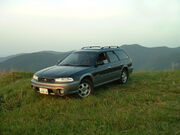
1998 Subaru Legacy Grandwagon Lancaster Limited (Japan)
The Legacy Outback was formally introduced to the North American market at the 1994 New York Auto Show, and was known in Japan starting August 1995 as the Legacy Grand Wagon, and in Australia as the Liberty Outback, a trim package with normal ground clearance but an "SUV look" with two-tone paint and fog lights. For MY 1994, the Legacy wagon was available as the Alpine Sport and Sun Sport, which were Value Option Packages included on the "L" trim level wagon, and graphics denoting the option package installed. The exterior was designed by Olivier Boulay, who was hired by Subaru on a short-term basis. It became a separately-marketed line in the United States in 1996. At this point it gained Outback-specific changes included unique bumpers (with large driving lamps incorporated into the front bumper), tweed-like seats and door panel inserts, taller tires with more aggressive tread, and a 7.3 in (185 mm) ground clearance, with a 7.87 in (200 mm) ground clearance in Japan.
The previous generation Legacy wagon had an optional air suspension, which allowed the driver to temporarily increase the vehicle's ground clearance, however the permanent increased ride height used on the Outback proved to be more practical. Subaru sales had been declining up until that point in North American market. With the help of clever marketing, a trim level called the Outback intent on making the Subaru a more capable multi-terrain vehicle offered an affordable and fuel efficient alternative to the popular SUVs that were outselling Subaru's traditional offerings. The Legacy and Outback wagons were built at the Subaru of Indiana Automotive production facility in Lafayette, Indiana that also manufactured the Isuzu Rodeo, a traditional SUV with four-wheel-drive and an extended ground clearance.

1st-gen Legacy SUS Limited
In September 1997, the Japanese Legacy Grand Wagon was renamed Legacy Lancaster though 1998 cars retained the Grand Wagon nameplate along with the new Lancaster plate. The JDM Grand Wagon and Lancaster were only available with the DOHC 2.5 liter flat-4 engine, receiving a 10 hp (7.5 kW) improvement in 1998. Some Japanese-spec Grand Wagons came with digital climate control, plaid seat upholstery, a dual-range manual transmission and a Momo black leather steering wheel. Because the only engine available in Japan was the 2.5 liter engine, and the exterior dimensions exceeded Japanese regulations for vehicles classified as a "compact", Japanese buyers of the Grand Wagon were liable for taxes charged to larger cars, and was regarded as a luxury vehicle in Japan.
The Legacy SUS (for "Sport Utility Sedan") was launched with a limited production test run sold in New England (USA) in 1998 and, based on its success, was rolled out nationwide the following year. The "Limited" trim level package for the Outback wagon was standard equipment on the sedan body, with the addition of a hood scoop and trunk-mounted rear wing. The "SUS" moniker was removed with the introduction of the Second Generation.
Over the years since its introduction, Subaru has incorporated the Outback nameplate variously to the Outback wagon itself, and an Impreza-based Outback Sport model. All American Outback models are built at the Subaru of Indiana Automotive plant in Lafayette, Indiana. Plastic side cladding was not present on the side doors of the Outback; the lower half of the doors were painted a contrasting color also found on the front and rear bumper covers.
Second generation (2000–2004)[]
 | |
| Also called |
Subaru Legacy Lancaster (Japan) Subaru Legacy Outback (Europe) |
|---|---|
| Production | 2000–2004 |
| Body style(s) |
5-door station wagon 4-door sedan (USA only) |
| Engine(s) |
2.5L SOHC 165 hp (123 kW) H4 3.0L DOHC 212 hp (158 kW) H6 |
| Transmission(s) |
4-speed automatic 5-speed manual |
| Wheelbase | 104.3 in (2649 mm) |
| Length |
187.4 in (4760 mm) (wagon) 184.4 in (4683.8 mm) (sedan) |
| Width | 68.7 in (1745 mm) |
| Height |
63.3 in (1607.8 mm) (2000-01 wagon) 62.2 in (1579.9 mm) (2002-04 wagon) 58.3 in (1480.8 mm) (sedan) |
| Related | Subaru Legacy |

2000–2002 Subaru Outback Limited wagon (US)
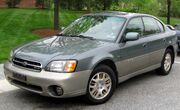
2002 Subaru Outback Limited sedan (US)
Based on the third generation Legacy, the Outback became its own model and the Legacy SUS remained unique to North America, and was realigned with the Outback Limited package, offering the sedan, with an optional horizontal six-cylinder engine, also optional on the wagon. This bodystyle was introduced to Japan September 1998, and was called the Lancaster for the second generation, with the six-cylinder in Japan called the Lancaster 6. The name Lancaster is used for cities in England, Australia, Canada and the United States. The USA-spec Outback was available starting in 2000. The Outback saw a competitor from Nissan in Japan only called the Nissan Avenir Blaster with a similar appearance to the Outback starting October 17, 2000.
The rear seat on the Outback sedan does not fold down, unlike previous generations where the rear seat had a 60:40 folding seat for extended length items. Rear headrests are now included as standard equipment on all trim levels. The ground clearance is 7.3 in (190 mm). The engine now meets California's Low Emission Vehicle emission standard.
All trim levels retained the typical AWD layouts seen in previous generation Outback, depending on transmission choice. Manual transmission models came with a mechanical "Continuous AWD" system which was normally 50/50 front/rear, and relied on limited slip differentials to redirect power front to rear, rear to front, and from one rear wheel to the other (when fitted with a rear limited slip differential). Automatic transmission models had an electronically-controlled AWD system that was 90/10 front/rear and redirected differing amounts of power to the rear wheels continuously. When accelerating or driving uphill, the vehicles weight shifts rearward, reducing front wheel traction, causing the transmission to automatically send torque to the rear wheels to compensate. When braking or driving downhill, the vehicle's weight shifts towards the front, reducing rear wheel traction. The transmission again compensates by sending torque to the front wheels for better steering control and braking performance. If the automatic is placed in Reverse or "1st" gear, the transmission divides the torque 50-50 to both front and rear wheels.
The Outback came standard with a 165 hp (123 kW) by SAE, 4-cylinder boxer engine, four-cylinder, a DOHC design in '98 and '99 before reverting back to the SOHC design; that, and maximum torque (166 lb·ft (225 N·m)) was available at a lower rpm. The 2.5 L SOHC four cylinder engine uses a timing belt that must be replaced around 100,000 miles (160,000 km), whereas the 3.0 L six cylinder engine uses a timing chain that doesn't require replacement under normal conditions.
The base model six-cylinder was offered as the H6-3.0 — its interior, and available options, were identical to those of the Outback "Limited", with the exception of manual transmission, which did not physically fit with the larger powerplant. Badging for all 6-cylinder Outbacks was located on the front grille as well as on the rear of the vehicle.
In a higher trim level, known as the Outback L.L. Bean in the USA, a 200 Watt McIntosh stereo system was standard from 2001 to 2003. These were some of the only vehicles ever factory-equipped with McIntosh stereo equipment. Options also included an in-dash six-disc CD changer, VDC (for Vehicle Dynamics Control), and dual moonroofs. OnStar was available as an option on the USA-spec L.L. Bean. In-dash satellite navigation was offered on Japan-spec vehicles on upper trim level wagons starting with Model Year 1998, and continued to offer a Momo black leather steering wheel with genuine wood inlay, gearshift knob and parking brake handle. Plaid upholstery was still offered on Japan-spec Lancasters.
The six-cylinder was also available as the VDC, with Subaru's VDC (Vehicle Dynamics Control) system, which integrated stability control with traction control. The system was also mated to a previously used Japanese-market AWD system, called VTD, in which power was split 45/55 front-to-rear in normal conditions. When wheel spin is detected, the system cuts power to the spinning wheel and directs power to those that aren't. Only when necessary do the brakes slow the affected wheels, when the vehicle detects excessive oversteer or understeer. This package had more sound insulation than other trims, as well as those features found on the L.L. Bean, such as McIntosh stereo, OnStar, and leather interior. Its curb weight was just slightly higher than that of the standard L.L. Bean trim, and while the VDC badging was placed on the front quarter panels only, the H6-3.0 and Outback markings were also applied as usual.
Australia[]

1998-2003 Subaru Outback 2.5i wagon (Australia)

2000–2003 Subaru Outback H6 3.0i wagon (Australia)
Australian-specification vehicles differ from cars delivered in the United States by following the Japanese models; primarily headlights, side indicators (on front quarter panels), rear tail lights, front and rear bumpers and a higher placing of the "Outback" badging on the front door bodywork (as opposed to being placed on the plastic cladding).
This generation of Outback was released in an early style with gold coloured cladding, all-in-one headlights (not dissimilar to the US model headlights) and internally a light gray cloth (sometimes speckled with various colours), a light brown wood textured dashboard and a plain instrument cluster. A nudge bar (a smaller style of bullbar or roobar) was also available as an aftermarket option. The later style (2002–2004) was updated with silver cladding, an updated range of paint colours, multi-unit headlights (where headlight and indicators were in different sections of the unit) and internally a dark gray/black cloth, dark gray plastics, a very dark brown faint wood texture and metal trims on the dials of the instrument cluster.
Models available included the base "Outback", the "Outback Limited" which added a sunroof and cloth/leather seats and the "Outback H6" which included the 6 cylinder engine with VDC as described in this article. The H6 was released with slightly different 16" wheels and available in a single metallic pearl off-white colour instead of the usual colour with gold or silver cladding. The H6 was only available in automatic, apparently due to the size of the 6-cylinder engine taking up too much space to fit the manual box and associated dual range mechanicals.
Subaru Baja[]
- Main article: Subaru Baja
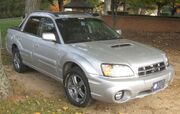
2004 Subaru Baja Turbo
The Subaru Baja (pronounced ba-ha) was a light-utility, all-wheel-drive, four passenger, four-door crossover manufactured from 2003-2006 by Subaru. The Baja combined the handling and passenger carrying characteristics of a car with the open-bed versatility, and to a lesser degree, load capacity of a pickup truck.
The unibody design borrowed heavily from existing mechanicals, platform and sheetmetal of the second generation Subaru Outback wagon.[2] Production began on July 18, 2002[3] as a 2003 model at the Lafayette, Indiana, factory (Subaru of Indiana Automotive, Inc., aka SIA) once shared with Isuzu.
The Baja's concept recalls many similar car-based, open-bed vehicles:
- Subaru's earlier BRAT four-wheel-drive, unibody pickup marketed in the US from 1978–1987
- Other small US-marketed unibody pickups: Volkswagen Caddy, Dodge Rampage/Plymouth Scamp
- The prominent US rear-wheel drive Ford Ranchero and Chevy El Camino[4]
- the two- and four-door vehicles of Australia, known as Utes
- much earlier American car-based pickup truck known as Coupe Utilities.
The Baja is named after Mexico's Baja California peninsula—home to the Baja 1000 off-road race.
Third generation (2003–2009)[]
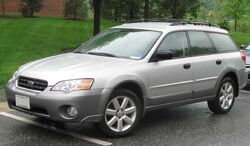 | |
| Also called | Subaru Legacy Outback (Japan and Europe) |
|---|---|
| Production | 2003–2009 |
| Body style(s) |
5-door station wagon 4-door sedan (USA only from 2005–2007) |
| Engine(s) |
2.5L SOHC 175 hp (130 kW) H4 2.5L DOHC 250 hp (186 kW) H4 turbo 3.0L DOHC 250 hp (186 kW) H6 2.0L turbodiesel 148 hp (110 kW) H4 (EU) |
| Transmission(s) |
4-speed automatic 5-speed manual 5-speed automatic |
| Wheelbase | 105.1 in (2670 mm) |
| Length |
188.7 in (4793 mm) (2005-07 wagon) 186.2 in (4729 mm) (sedan) 189 in (4801 mm) (2008-present wagon) |
| Width | 69.7 in (1770 mm) |
| Height |
63.2 in (1605 mm) (wagon) 59.1 in (1501 mm) (sedan) 61.6 in (1565 mm) (2008-present base wagon) |
| Fuel capacity | 16.9 US gallons (64.0 L/14.1 imp gal) |
| Related |
Subaru B9 Tribeca Subaru Legacy |
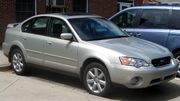
3rd-gen Subaru Outback Limited sedan (USA)

2003–2007 Subaru Outback (Australia)

2007–2009 Subaru Outback (Australia)

2008-2009 Subaru Outback (US)
October 22, 2003, with the debut of the fourth-generation Legacy at the 60th Frankfurt Auto Show, the Outback name is now being used in all markets with the launch of the third-generation Outback wagon, in order to rationalize the name Outback, which prior to then had only been used in export markets. Models equipped with a 3.0 L H6 were introduced at the 2004 Chicago Auto Show. The ground clearance is 8.5 in (220 mm).
The Outback carries the same model codes as the Legacy Wagon, BP9 for the 2.5 liter, and BPE for the 3.0 liter model. The highest trim level offered in the USA is the Outback L.L. Bean that offers optional equipment as standard, including wood and leather steering wheel, an auxiliary port on the stereo for MP3 compatibility, perforated leather seats, GPS navigation, double sized, one piece, glass moonroof and the H6.
A new Outback variant for 2005+ is the Outback XT. This model comes with Subaru's turbocharged 2.5L 4-cylinder engine found in the Impreza WRX model. This engine produces 243 hp (181 kW), which is much higher than the naturally aspirated 2.5L producing 175 hp (130 kW). The XT model can be equipped with any of the 3 standard transmissions: 4-speed Auto-SportShift, 5-speed Auto-SportShift, or 5-speed manual.
In July 2008, Subaru ceased offering a special edition L.L. Bean trim level on the Outback.[5] Subaru beefed up their AWD 4EAT transmission's design and released the 5EAT w/ SportShift in 2005 The Outback received styling revisions for the 2008 model year, notably an enlarged, chrome-ringed grille. As of the 2008 model year, the Legacy wagon and Outback sedan were discontinued in the United States, leaving the Legacy sedan and Outback wagon. The JDM and EU diesel model has a "Start/Stop" button (in the top-of-the-line-model), found in Lexus, Infiniti, Audi and other high end makers.
For 2008, the 2.5i USA model has been certified PZEV emissions, and a badge has been attached to the rear of the vehicle on the bottom right hand side of the tailgate. All other models are certified LEV2. The PZEV Outback is available for sale in all 50 states, unlike other manufacturers who only sell PZEV certified vehicles in states that have adopted California emission standards.
In 2007, the Outback (along with the Ford Mondeo) won Top Gear's "Car of the Year" award.[6]
EyeSight[]
Starting May 2008, the Japanese-spec Legacy could be fitted with a new safety feature called EyeSight. It consists of two cameras, one on each side of the rear view mirror, that use human-like stereoscopic vision to judge distances and generally keep tabs on the driver. The system helps maintain a safe distance on the highway, warns the driver during unintended lane departure, emits a wake up call should everyone else pull away from the traffic lights, and keeps an eye out for pedestrians.[7][8] SI-Cruise has been integrated into the EyeSight feature as a driver safety aid.
Diesel[]
The Subaru EE series flat-4 diesel engine is offered in both Legacy and Outback models in Europe exclusively. Identified as the Subaru Outback 2.0D, the vehicle was released March 2008. The vehicle is offered with a 6-speed manual transmission only. The official introduction of the Legacy and Outback diesel was at the Geneva Motor Show in March, 2008.
According to the Subaru Owners on-line newsletter dated March 2008, Subaru is "currently making modifications to the diesel so it meets the more stringent U.S. standards. Subaru diesel models should be domestically available in two to three years."[9][10][11]
Engines[]
| Model | Years | Type (code) | Power, torque@rpm |
|---|---|---|---|
| Global engines | |||
| 2.5i | 2005- | 2,457 cc (2.5 L/149.9 cu in) SOHC H4 N/A (Naturally Aspirated) (EJ253) | 173 PS (127 kW/171 hp)@6000, 227 N·m (167 ft·lbf)@4400 |
| 3.0R | 2004- | 3,000 cc (3.0 L/183.1 cu in) DOHC H6 AVCS (EZ30) | 245 PS (180 kW/242 hp)@6000, 297 N·m (219 ft·lbf)@4200 |
| 2.0D | 2003?- | 1,998 cc (2.0 L/121.9 cu in) DOHC H4 turbodiesel (EE20) | 150 PS (110 kW/148 hp)@3600, 350 N·m (258 ft·lbf)@1800 |
Transmissions[]
| Model | Years | Type | |
|---|---|---|---|
| Global engines | |||
| 2.5i | 2003?- | 5-speed manual dual range, 4-speed Sportshift | |
| 3.0R | 2003?- | 5-speed Sportshift | |
| 2.0D | 2008–2009 | 6-speed manual | |
Fourth generation (2009–)[]
 | |
| Manufacturer | Subaru |
|---|---|
| Parent company | Fuji Heavy Industries |
| Production | 2009– |
| Body style(s) | 5-door station wagon |
| Layout | AWD |
| Engine(s) |
2.0 L DOHC turbodiesel 148 hp (110 kW) H4 |
| Transmission(s) |
Lineartronic CVT 5-speed automatic 6-speed manual |
| Wheelbase | 107.9 in (2740.7 mm) |
| Length | 188.2 in (4780.3 mm) |
| Width | 71.7 in (1821.2 mm) |
| Height | 65.7 in (1668.8 mm) |
| Curb weight | 3,658 lb (1,659 kg) (3.6R Limited) |
| Fuel capacity | 18.5 US gal (70 L/15 imp gal) |
| Related |
Subaru Legacy Subaru Tribeca Subaru Exiga |
The fourth generation Subaru Outback was introduced in April 2009 at the New York Auto Show, the fifteenth anniversary of the first Outback's introduction at the same event. The Outback was introduced in Japan May 20, 2009.[12] The "Legacy" prefix has been dropped internationally. Air Bags are offered for the driver and front passenger, side bolster airbags for front seats on the outer edge, side curtain airbags for front and rear passengers and a knee bolster air bag for the driver.
The ground clearance increases to 8.7 in (220 mm), and is the ninth Subaru vehicle to feature continuously variable transmission (CVT). The double-sized moonroof is no longer being offered, and has been reduced to a conventional size that doesn't extend over the rear seats. The turbocharged engine is also no longer offered on all international versions of the Outback. An engine coolant temperature gauge is no longer offered, replaced by a fuel economy gauge instead. When the engine temperature is below normal, an indicator light shines blue and when the engine is overheating, the light turns red. Using the key to unlock the drivers door after locking the vehicle with the remote will set off the security system; the vehicle must be unlocked with the remote, a tradition going back to the first generation when remote keyless access was introduced.
The side windows are no longer frameless, ending a Subaru tradition started with the first generation Leone in the early 1970s. The "D" pillar on the wagon is no longer covered in glass, also ending a design tradition established with the first generation and borrowed from the Subaru XT. The front and rear bumper covers are no longer painted a contrasting color, but the plastic side body cladding continues. The external "Limited" badge has been retired on North American vehicles, and if the vehicle has the 3.6 L six cylinder engine, the rear of the vehicle has a "3.6R" badge applied internationally. Black housing for headlights is not offered on the Outback worldwide. The Outback with 2.0 L diesel engine can be distinguished by its hood scoop and "Boxer Diesel" emblem on the rear. January 21, 2010, the Outback was introduced for sale in South Korea.
Subaru introduced improvements to the chassis that they call Dynamic Chassis Control Concept, which uses high-tensile steel in critical areas to achieve high strength with lighter weight. The front-end structure introduces Cradle Mount that isolates the suspension and engine from the passenger compartment for a smoother and quieter ride using rubber mounts. New for this generation is a double wishbone rear suspension, with all suspension links and the rear differential isolated from the rear subframe with large rubber mounts to minimize noise and vibration intruding into the passenger compartment. Subaru has also added safety technologies such as Electronic Stability Control, Brake Assist, and Electronic Brakeforce Distribution to the list of standard features.
In North America, the fifth generation Outback won Motor Trend magazines Sport/Utility of the Year Award for 2010, and Ward’s Automotive Group's 2010 Interior of the Year awards in the popular-priced car category under $29,999.[13]
North American models[]
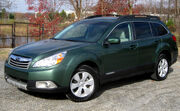
2010 Subaru Outback 2.5i Limited (US)
Trim level designations have been modified based on the engine installed; the Subaru EJ engine 2.5 L naturally aspirated engine are labeled 2.5i, 2.5i Premium, and 2.5i Limited, with the Subaru EZ 6-cylinder engine identified as 3.6R, 3.6R Premium and 3.6R Limited. As with previous generations, leather interior is only available in 2 colors (Warm Ivory or Off-Black) on Limited trim packages on specific exterior colors, and a glass moonroof is optional only on the Limited; cloth interiors are offered in the specified colors on lower trim level packages. A 440 W, 9-speaker Harman/Kardon audio system, using Dolby Pro Logic II technology and DTS Digital Sound, with Bluetooth and iPod capability is optional on the Limited trim packages. An 8 in (203.2 mm) voice activated GPS touch screen navigation system is optional only on the Limited. A separate Bluetooth wireless package with voice recognition, called Blueconnect, is available on lower trim levels and is not offered internationally. A Harman/Kardon-sourced stereo with a 6-disc in-dash CD changer and SRS Circle Surround sound is the standard sound system provided, with six speakers on all trim levels. A dual zone digital climate control system with 6-speed fan is standard and only available on the Limited; the base and Premium model have a 4-speed fan. Base and Premium trim levels have silver metallic trim on the interior door panels and dashboard; the Limited trim package has woodgrain accents.
All trim levels are fitted with a retractable roof installed luggage rack, where the crossmembers are permanently attached but can be swung into the luggage carrier support structure when not in use, currently available only on North American models. Also, the North American Outback has lower side body claddings, which are not applied to ROW models (although the cladding may come on ROW models as a dealer-installed option). The interior retractable rear cargo cover has a separate storage compartment in the spare tire storage area so that the cargo cover can be removed for large items but stored inside the vehicle and out of the way. The rear seatbacks can be partially reclined for comfort.
All models are now available with painted exterior door handles, with black exterior side mirrors on the base level 2.5i, and painted mirrors on Premium and Limited. The Limited can be identified externally by simulated aluminium surround for the front foglights and matching trim piece on the bottom edges of the side door sill protector, front, and rear bumpers; the Premium and base model remain black. The grille appearance is unique on North American models so as to provide a visual similarity to the larger facelifted Tribeca and the third generation Forester. The 2.5i uses the flat-4 engine with 6-speed manual transmission or the optional Lineartronic Continuously variable transmission with steering column mounted paddle shifters that allows the driver to select 6 "virtual gears" in manual mode. The 3.6R uses the flat-6 engine (from the Subaru Tribeca) exclusively with a 5-speed automatic transmission. The conventional automatic transmission is only available with the flat-6 engine, and the 6-speed manual transmission is not available on the 2.5i Limited. The PZEV Outback 2.5i, identified by a badge attached to the rear of the vehicle, continues to be sold in all 50 states, unlike other manufacturers who only sell PZEV certified vehicles in states that have adopted California emission standards. All other models have been certified LEV2 or ULEV.
Japanese models[]
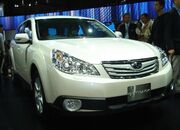
JDM Subaru Outback 3.6R (note difference in front grille, side mirror installed turn signals, and pop-up headlight washers)
The Japanese-specification Outback is available with either the 2.5 L flat-4 or the 3.6 L flat-6 engine.[14] The EJ20 engine is no longer used in the Legacy or the Legacy Outback.[15] The trim levels are 2.5i, 2.5i L package and 3.6R and 3.6R SI-Cruise. SI-Cruise is an autonomous cruise control system that can reduce or resume a preset speed or bring the vehicle to a complete stop if the system detects a slower vehicle is being followed, without driver intervention. Air vents are installed for rear passengers at the back of the center front armrest compartment. The front hood (bonnet) and front bumper covers are not interchangeable with the North American version due to slight changes in the sheet metal. Turn signal repeaters are still integrated into the side exterior mirrors on all Japanese-spec models. Woodgrain accents are standard on the "L" package and the SI-Cruise vehicle, silver accents on lower trim levels.
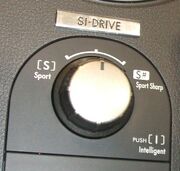
SI-Drive control knob (earlier version)
SI-Drive, or Subaru Intelligent-Drive,[16] (Japanese: SI-Drive) is standard equipment on all trim versions. It is a feature that enables three distinctly different modes of vehicle performance characteristics (identified as "Sport", "Sport Sharp", and "Intelligent") by regulating the engine control unit (ECU), the automatic transmission control unit (TCU, if equipped), and by fine-tuning the electronically controlled throttle. The SI-Drive control knob is installed on the center console between the heated front seat control switches. The "Intelligent" mode makes throttle response more gradual, and decreases maximum engine power by 10 percent. The "Sport" mode allows the engine to run at higher speeds and increases fuel efficiency by 5 percent in comparison to Subaru engines without the feature. The "Sport # (Sharp)" mode makes throttle response more abrupt and enables the automatic transmission to maintain higher RPMs within a given gear's range, and minimizes the electric power steering wheel effort. When the engine is started, the default setting is the "Sport" selection.
Japanese buyers can choose two different premium level entertainment systems; they can select the previously described Harman/Kardon GPS-stereo with six speakers, or a McIntosh sourced GPS/stereo with Dolby Digital 5.1 Surround Sound, a separate powered amplifier and 10 speakers. Both units are Gracenote, G-BOOK and VICS enabeled, with both systems available with an internal 600 MHz 40GB HDD coupled with a digital TV tuner that can be watched when the transmission is in park and the parking brake applied. Both stereos are compatible with CD, CD-R/RW, DVD and DVD R/RW as well as MP3 and WMA music formats. A Harman/Kardon sourced stereo with a 6-disc in-dash CD changer and SRS Circle Surround sound is the entry level sound system offered with six speakers and is standard equipment. The McIntosh stereo facia is offered in the trademark black with a clear plastic overlay and the center dashboard trim piece retains the brushed aluminum appearance but the color is black, with the climate controls offered in a matching black appearance, instead of the standard silver. Oddly, the Japanese version has a retractable cover for the console installed cupholders, whereas the North American version has exposed cupholders without a retractable cover. The dual-zone climate control system is standard on all trim levels.
The GPS navigation system can be displayed in a split-screen format showing both two- and three dimensions with graphic landmarks instead of a flat screen without geographical images. HID headlights are standard on all models except the base 2.5i, as well as automatic rain sensing windshield wipers and headlight washers. A smart key is available as an option coupled with two position memory seat that memorizes driver's seat positions and adjustments, exterior mirror adjustment, and climate control settings. The settings can be customized based on the smart key module being used to unlock and start the car. The Outback can be fitted with twin white LED lights installed on the interior hatch vertically surrounding the rear window, with a separate light switch for additional illumination when the rear hatch is open.
On the one year anniversary of the introduction of the fourth generation, "EyeSight" was once again offered on the Japanese-spec Outback. EyeSight consists of 2 cameras with one on each side of the interior rear view mirror, that use human-like stereoscopic vision to judge distances and generally keep tabs on the driver. The system can help maintain a safe distance on the highway, a lane departure warning system, a wake up call when traffic lights change, and even keeps an eye out for pedestrians. SI-Cruise has been integrated into the EyeSight feature as a driver safety aid.
European models[]

2010 Subaru Outback 2.0D (BR)
The European engine choices are the flat-4 EE20 2.0 L turbodiesel, the EJ25 2.5 L or the EZ36 3.6 L flat-6, with SI-Drive available only on the six cylinder. Trim level packages are the 2.0D Comfort, Trend and Active, the 2.5i Comfort and Trend, or the 3.6R Exclusive. The interior colors of Warm Ivory or Off Black are offered, but the Warm Ivory interior is only available in leather. Wood accents are only available on the Exclusive trim package. The dual-zone climate control system is standard on all trim levels. The turbodiesel is available with the Warm Ivory interior with the Harman/Kardon sound system with six speakers and the satellite navigation, but the only transmission offered is the six speed manual transmission. Cruise control, heated seats, automatic windshield wipers, HID headlights with headlight washers, heated exterior mirrors, glass moonroof and 17" wheels are standard equipment. The smart key is available only on the Exclusive or Comfort trim packages, coupled with the satellite navigation system and memory seats. The front hood (bonnet) and front bumper covers use the Japanese configuration, with turnsignal repeaters on the exterior mirrors, and standard equipment front and rear foglights. The turbodiesel and the 2.5i engines are Euro5 compliant.
United Kingdom models[]
The Outback is available to United Kingdom buyers with a choice of the flat-4 Subaru EE turbodiesel with a 6 speed manual transmission, the 2.5 L flat-4 with the CVT transmission, or the 3.6 L flat-6 engine with SI-Drive and an 5-speed automatic transmission. The trim level packages are the 2.0D SE and 2.0D SE NavPlus diesel, the 2.5i SE and the 2.5i SE NavPlus and the 3.6R. The interior is offered in black only, with leather on all trim levels. The interior trim strips on the doors and dashboard are silver on all models except the 3.6R, which has woodgrain trim. The front bumper and bonnet use the Japanese configuration, to include self levelling HID headlights and headlight washers. The UK and Europe are offered an exterior paint selection, called Camellia Red Pearl that is not available in Japan or North America. For vehicle security, a Thatcham Category 1 perimeter alarm and immobiliser, along with a rolling code ECU engine immobiliser are standard equipment. The dual-zone climate control system is standard on all trim levels. The 2.5i and the turbodiesel engines are Euro5 compliant.
The smart key is available on NavPlus and 3.6R models only. 17" alloy wheels are standard on all models, as well as rain sensing automatic wipers, two position memory seat, heated exterior mirrors, glass moonroof, heated front seats, fog lights, and tilt and telescoping steering wheel. The Harman/Kardon stereo with 6 speakers and the rear view backup camera is installed only on vehicles with the voice recognition NavPlus system. The standard stereo system uses an in-dash 6-disc CD auto-changer and automatic speed-sensing volume adjustment that is MP3 player compatible.
South African models[]
The Outback is offered with black interior; specifications are similar to European "Comfort" trim package. Outback 2.5i Premium is available with the choice of Lineartronic CVT or six-speed manual transmission, including leather trim, memory function for the driver’s seat, electric sunroof, dual zone climate control and rear air vents. Satellite navigation is not offered along with the premium Harman/Kardon sound system.
Recently, the 2.0 diesel (6-speed manual only) and 3.6R models have been introduced.
Australian models[]

Australian interior with McIntosh stereo system
The Outback sold in Australia resembles the vehicle sold in Europe, with some features only available in Japan. The trim level packages are the 2.5i, 2.5i Premium, 2.5i Premium SatNav, the 3.6R, 3.6R Premium SatNav and the diesel 2.0D, 2.0D Premium, 2.0D Premium SatNav. The engines offered are the EJ25, EZ36 and the EE20 turbodiesel. Australians can choose either the Lineartronic CVT or a 6-speed manual transmission on the EJ25, but transmission choices on the EZ36 are limited to the 5-speed automatic, and the EE20 turbodiesel is available with the 6-speed manual transmission exclusively. The Off Black interior color is standard across the range, however the Warm Ivory is available on the 3.6R, with leather interior offered on vehicles identified as "Premium". Cloth is offered on the 2.5i, 3.6R and the 2.0D. SI-Drive is only available on the 3.6R, following the international trend. The front bumper and hood (bonnet) use the Japanese configuration. The Australian EJ25 and EE20 engines are Euro4 compliant.
The dual-zone climate control system is standard on all trim levels. Sound systems offered include the McIntosh stereo with 10 speakers, a separate powered amplifier and satellite navigation provided by "WhereIs", a service provided by Telstra Corporation Ltd, or the Harman/Kardon stereo with the satellite navigation and 6 speakers, or the unit offered in North America and Europe with a 6-disc in-dash CD changer and 6 speakers. The McIntosh unit sold in Australia has function buttons written in English and is different than the Japanese unit, due to Japanese characters being used on some of the functions. The Australian McIntosh or Harman/Kardon GPS-stereo packages are not Gracenote, G-BOOK and VICS enabled, and do not have the internal 600 MHz 40GB HDD coupled with a digital TV tuner. The center dashboard trim is color matched based on the stereo installed; if it has either one of the Harman/Kardon units, the trim color is silver brushed aluminum, and if the McIntosh is installed the trim color is black brushed aluminum. The climate controls are also colored either silver or black as well. Silver trim is installed on the doors and dashboard, with woodgrain available only on the 3.6R. Cruise control, heated seats, automatic windshield wipers, HID headlights with headlight washers, heated exterior mirrors, and 17" wheels are standard equipment. The smart key is available only on the 3.6R, and the glass moonroof is only offered on Premium trim packages.
Engines[]
| Model | Years | Type (code) | Power, torque@rpm |
|---|---|---|---|
| Global engines | |||
| 2.5i | 2009- | 2,457 cc (2.5 L/149.9 cu in) SOHC H4 N/A (Naturally Aspirated) i-AVLS (EJ253) | 167 PS (123 kW/165 hp)@5600, 229 N·m (169 ft·lbf)@4000 |
| 3.6R | 2009- | 3,629 cc (3.6 L/221.5 cu in) DOHC H6 dual AVCS (EZ36) | 260 PS (191 kW/256 hp)@5600, 350 N·m (258 ft·lbf)@4400 |
| 2.0D | 2009- | 1,998 cc (2.0 L/121.9 cu in) DOHC H4 turbodiesel (EE20) | 150 PS (110 kW/148 hp)@3600, 350 N·m (258 ft·lbf)@1800-2400 |
Transmissions[]
| Model | Years | Type | |
|---|---|---|---|
| Global engines | |||
| 2.5i | 2009- | 6-speed manual, Lineartronic CVT | |
| 3.6R | 2009- | 5-speed Sportshift | |
| 2.0D | 2009- | 6-speed manual | |
Subaru Outback Sport[]

1995–2001 Subaru Outback Sport
The Outback Sport was first introduced in 1995 as an updated Impreza "L" Sport Wagon, and is currently offered only in the USA. The Outback Sport is the top trim level of the Impreza wagon model with no significant mechanical or performance changes from the lower trim levels. The Outback Sport package was never available on the Impreza sedan or coupe from Subaru, unlike the Outback package being available on both the Legacy-based sedan and wagon (due to the size, the Outback Sport was smaller than Outback).
One engine was offered, which was the 2.2 liter, and it was the first time the 2.2 engine was used in the American Impreza. Later, the 2.5 engine was introduced. In Japan, the Impreza Sport Wagon was offered with a similar approach to the Outback Sport, calling it the Impreza Gravel Express with the WRX turbocharged engine. Subaru discontinued the Gravel Express when the second generation Impreza was introduced due to very limited sales, and introduced the Subaru Forester as a replacement. The hoodscoop found on the American Outback Sport was non-functional but was probably included because the American and Japanese versions were built at the same factory in Japan. The Outback Sport was offered with optional equipment, such as a gauge pack installed on top of the dashboard, that included a digital compass, outside temperature and barometer or altimeter readings.

2008–2009 Subaru Outback Sport
The Second Generation Outback Sport was sold in Australia for model years 2001-2007, but it was renamed as the Impreza RV with the same color scheme as the American version.[17][18] The Australian version had a dual-range manual transmission, not available in the USA.
Subaru found some sales success with the Outback Sport as a smaller companion with similar ride height changes, body colors and trim levels to the larger, more successful selling Legacy based Outback. The Outback Sport "incorporates the performance features of an Impreza with the rugged durability of the Outback" according to the Outback Sport website,[19] continuing to offer it as a trim option of the Impreza, with exterior cosmetic and interior equipment modifications.
It is an alternative for buyers who don't like the SUV/CUV appearance of the Forester and don't need the extended ground clearance. The Outback Sport has been offered for the same amount of time as the larger Legacy wagon based Outback, but the larger Outback has seen more sales than the smaller Outback Sport. Mechanically, the Outback Sport is the same as the standard Impreza hatchback; no high performance equipment found on the Impreza WRX or STi is included on the Outback Sport. The slight increase in ground clearance is due to the larger wheels equipped on the Outback Sport, and not a result of suspension modification.
Outback Sport models can be easily identified from the standard Sport Wagon or newly released 5 door hatchback by the color of the front and rear bumper covers and matching door rub strip that are painted a contrasting color from the paint used for the rest of the car, a coloring scheme also used on the larger Outback.
At the 2010 Geneva Motor Show, the third generation Outback Sport was introduced to Europe with the name Impreza XV.
References[]
| This page uses some content from Wikipedia. The original article was at Subaru Outback. The list of authors can be seen in the page history. As with Tractor & Construction Plant Wiki, the text of Wikipedia is available under the Creative Commons by Attribution License and/or GNU Free Documentation License. Please check page history for when the original article was copied to Wikia |
Fourth generation information was obtained from sales brochures from specific international markets; brochures were printed between June and September 2009.
- ↑ 1.0 1.1 Haas, Al (2008-08-02). "The 2010 Subaru Outback: a rugged redesign", Philly.com. Retrieved on 2009-08-20.
- ↑ "First Drive: 2003 Subaru Baja". PickupTruck.com August 9, 2002.
- ↑ "Subaru of Indiana History". Subaru.com.
- ↑ "Subaru makes another bold move with Baja", USAtoday, James R. Healey (August 19, 2002). Retrieved on May 24, 2010.
- ↑ "Subaru and L.L. Bean part company". Blogs.cars.com. Retrieved on 2010-11-20.
- ↑ Top Gear, Series 10, Episode 10, 12/23/2007
- ↑ "Introduction of EyeSight technology retrieved September 4, 2008". Subaru.jp. Retrieved on 2010-11-20.
- ↑ Gardiner, Justin (2008-09-04). "Retrieved from Autoblog September 4, 2008". Autoblog.com. Retrieved on 2010-11-20.
- ↑ http://cars.uk.msn.com/reviews/articles.aspx?cp-documentid=147861912 Legacy Diesel Review retrieved January 22|22/01/08
- ↑ http://www.greencarcongress.com/2008/01/subarus-first-b.html Legacy Diesel Announcement retrieved 23/01/08
- ↑ http://www.autoblog.com/2008/02/08/geneva-08-preview-subaru-legacy-2-0d-and-outback-2-0d Legacy and Outback diesel announcement retrieved February 2|08/02/08
- ↑ "Legacy introduction in Japan". Subaru.jp (2009-05-20). Retrieved on 2010-11-20.
- ↑ Murphy, Tom (2010-04-12). "Interior Winners Deliver Style, Function, Value". Wardsauto.com. Retrieved on 2010-11-20.
- ↑ "SUBARU : 車種紹介 > レガシィ アウトバック". Subaru.jp. Retrieved on 2009-08-08.
- ↑ "Options list for Touring Wagon" (PDF). Retrieved on 2010-11-20.
- ↑ [1]
- ↑ "Australian-spec Impreza RV". Autospeed.com. Retrieved on 2010-11-20.
- ↑ https://www.aaa.asn.au/roadtests/reports/423.pdf Second Australian-spec Impreza RV review
- ↑ http://www.subaru.com/shop/overview.jsp?model=IMPREZA&trim=SPORT&command=overview%7CUSDM Outback Sport
External links[]
- Subaru Outback Official Page
- Subaru Outback global site: MY2009, MY2010
- Subaru Outback at the Open Directory Project
| Subaru, a division of Fuji Heavy Industries, vehicle timeline, 1990s–present | |||||||||||||||||||||
|---|---|---|---|---|---|---|---|---|---|---|---|---|---|---|---|---|---|---|---|---|---|
| Type | 1990s | 2000s | 2010s | ||||||||||||||||||
| 0 | 1 | 2 | 3 | 4 | 5 | 6 | 7 | 8 | 9 | 0 | 1 | 2 | 3 | 4 | 5 | 6 | 7 | 8 | 9 | 0 | |
| Kei car | Rex | Vivio | Pleo | Pleo | |||||||||||||||||
| R1 (RJ) | |||||||||||||||||||||
| R2 (RC) | Lucra | ||||||||||||||||||||
| Stella | |||||||||||||||||||||
| Microvan Kei truck |
Sambar / Domingo | Sambar | Dias Wagon (Daihatsu Atrai) | ||||||||||||||||||
| Subcompact | Justy KA | Justy GM M platform | Justy HT51S | Justy M310S | |||||||||||||||||
| Dex | |||||||||||||||||||||
| Compact | Leone/Loyale AC/AG/AN | Leone delivery van Y10 | Leone delivery van Y11 | ||||||||||||||||||
| Impreza GC/GF/GM | Impreza GD/GG | Impreza GE/GH/GR | |||||||||||||||||||
| Mid-size | Legacy BC/BF/BJ | Legacy BD/BG/BK | Legacy BE/BH | Legacy BL/BP | Legacy BM | ||||||||||||||||
| Sports coupé | XT AX | SVX CX | |||||||||||||||||||
| Compact MPV | Traviq GM T platform | Exiga YA | |||||||||||||||||||
| Crossover/SUV | Forester SF | Forester SG | Forester SH | ||||||||||||||||||
| Outback BG | Outback BH | Outback BP | Outback BR | ||||||||||||||||||
| Tribeca WX | |||||||||||||||||||||
| SUT | BRAT | Baja BT | |||||||||||||||||||
| Current | Dex · Exiga · Forester · Impreza · Legacy · Lucra · Outback · Pleo · R1 · Sambar · Stella · TransCare · Tribeca | ||||||||||||||||||||
| Engines | EA · EE · EF · EG · EJ · EK · EL · EN · EZ · AVCS · i-AVLS · FB | ||||||||||||||||||||
| Historic | 1500 · 360 · 1000 · Alcyone XT · Alcyone SVX · Baja · BRAT · FF-1 G · FF-1 Star · Justy · Leone · Sumo / Libero / Domingo / Columbuss (Europe) · R-2 · R2 (Modern) · Rex · Traviq · Vivio | ||||||||||||||||||||
| Concept | Subaru B11S · G4e · B5 TPH · B9 Scrambler · R1e | ||||||||||||||||||||
| Miscellaneous | Subaru.com • Subaru Global official site • Fuji Heavy Industries official site • Love. It's what's makes a Subaru, a Subaru. • Parent: Fuji Heavy Industries • | ||||||||||||||||||||